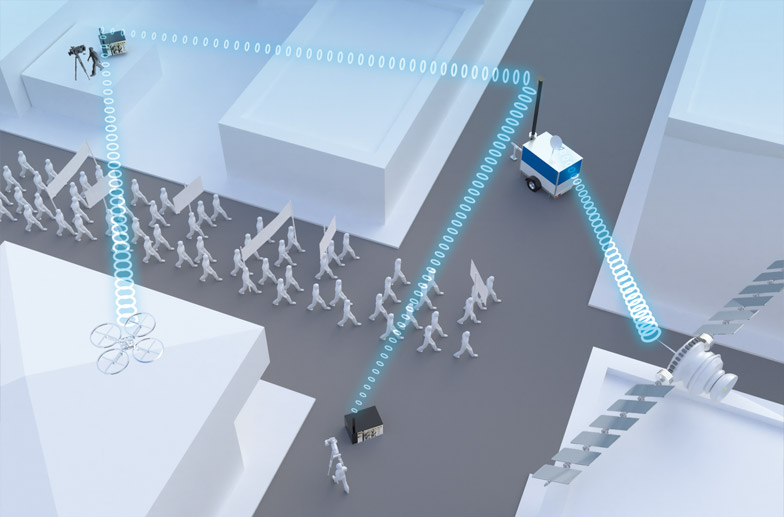C
Broadband Networks for Security & Public Safety
Broadband Networks for missions in Public Safety & Security context
Public Safety & Security Organisations have been using mobile broadband services and applications for quite some time. Already today, various smartphone Apps like e.g. secure Police messengers and license plate recognition are helping the mission forces optimize their daily work. Furtermore, the exchange of videos, high resolution pictures and other sensor data between forces in the mission area but also the transmision of such data to the Command & Control centre are getting more and more important. Access to the network and databases from the field is another critical use case.
VITES offers solutions for the mentioned scenarios in form of mobile (better „nomadic“) communication solutions in form of mobile LTE-Cells as well as IP-Mesh-Networks. Both technologies are ideal complements to each other and can easily be combined. The integration of existing terminals like e.g. laptops, tablets, smartphones, IP-cameras, body-cameras and even drones is straight forward.

Mobile („nomadic“) LTE-Cells
In Germany and internationally, Public Safety & Security organisations are using official smartphones for their daily work, not only for secure messenger Apps but also for other broadband data services.
However, full coverage on base of a dedicated and secure cellular network for the organisations mentioned above, does barely exist anywhere. Therefore, in most cases commercial networks are being used with all the implied consequences. They typically can’t fulfill the requirements completely: in case of a blackout, the battery runtime is a couple of hours only and availability as wellas coverage in rural or remote areas are not sufficient. Inparticular in the event of large scale missions, commercial networks tend to become overloaded or unavailable.
A solution for the challenges mentioned above can be mobile (or better: nomadic) cellular networks using LTE- or in future 5G-Technology. The required equipment can be installed in vehicles that -once in the mission area- will provide a radio cell for the cellular connectivity of the mission forces resp. their terminals.
Combined with IP-Mesh networks (MANET) they represent a scalable broadband communication solution for large scale missions, disaster relief and similar incidents.
Usable frequencies are different per country, but the 700 MHz-band which has been reserved for such applications in a number of EU-countries, seems appropriate, also wrt. range and availability of appropriate radio base stations. Furthermore, most up-to-date smartphones do support these frequency bands and thus offer a more economic and quicker way of equipping the mission forces, than dedicated devices.
However, equipment is available for any frequency secified in the LTE-standards.
VITES will supply, integrate and configure the complete cellular network according to our customers‘ requirements, see ViCELL
IP-Mesh-Networks
IP-Mesh-Networks typically are mobile ad-hoc-networks (MANET) that consist of a number of mobile routers, that establish a full mesh, self-routing network for any kind of IP-data in the mission area.
As a reliable, robust and mature solution for such kind of ad-hoc networking for public safety and security authorities, VITES offers the ViMesh product line. The included HiMoNN-routers are well established and successful in the market for many years. They are being used by numerous organisations e. g. police, fire brigade, technical support forces but also in the industrial sector in context of critical infrastructure.
Due to its performance qualities, HiMoNN typically provides advantages in situations where task forces have communication demands, but where a communication infrastructure is not available, overloaded, not reliable or destroyed. This is, for example, the case during large scale disaster management operations like e.g. major fires or floods. Furthermore, HiMoNN brings a tremendous benefit for the monitoring of critical infrastructures, with major sports or other events, demonstrations or in case of hostage situations and other special operation tasks.
More and more often, rescue operations are coordinated centrally by regional control centres. The exchange of an accurate assessment with the respective control centre plays a very important role for reliable allocation of resources. In cases of emergency or damage, the complexity of infrastructures normally requires further information regarding the condition of buildings and systems at the operation site. The spectrum reaches from connecting control center systems, the integration of indoor radio systems via the transmission of video and thermal image information, up to the merging of measurement and sensor data as well as the networking of medical treatment places on big events or of entire plant areas.
Video data of the operation site – recorded via video drone, vehicle camera, helmet camera or other portable systems, combined with detailed position and sensor data enable precise assessment of the current situation and thus increase operational efficiency. Data is exchanged in real time between first responders, emergency vehicles and on-site sensors, and finally submitted to the operation control centre in bundled form. A head of operations is not required to be on-site for gaining an overview of the situation, but he is supplied with information at the control centre and can co-ordinate the operation together with other task forces, if necessary. In response, information from data bases is made available, such as building plans or safety measures in case of chemical hazards at the scene.
VITES very successfully offers a broad range of IP-Mesh products and associated options, see ViMesh.
